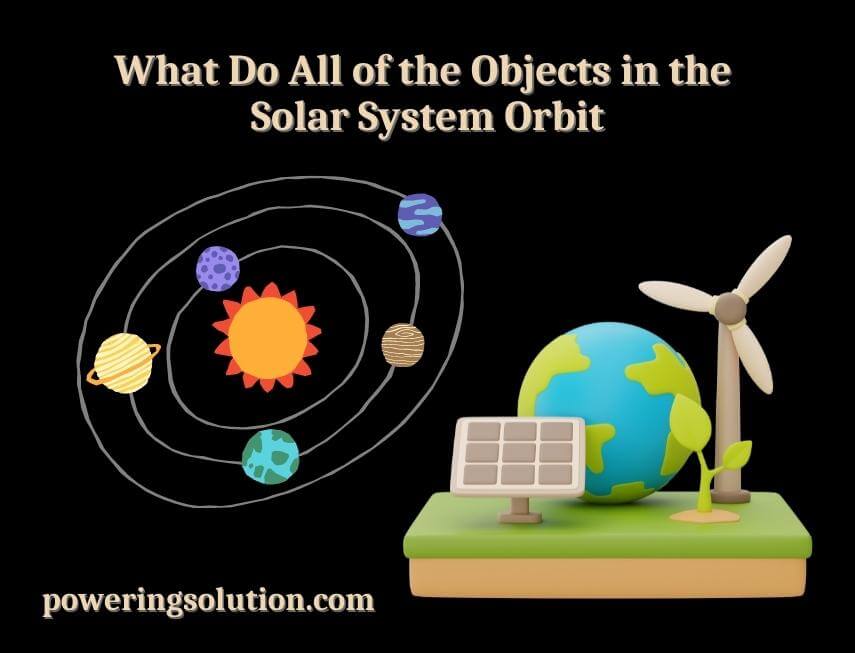Ever looked up at the night sky and marveled at the celestial bodies above? That’s our solar system, a stunningly complex and beautiful dance of objects in space. But what keeps this dance going? What do all of these objects revolve around? The answer is relatively simple: the Sun.

The Solar System: A Brief Overview
What constitutes the solar system?
The solar system consists of a myriad of celestial bodies, including the Sun, eight planets, moons, dwarf planets, asteroids, comets, and meteoroids. These objects constantly move in an intricate choreography, bound together by the force of gravity.
How objects move within the solar system
It might seem mysterious, but the movement of these celestial bodies is due to simple laws of physics. The gravitational pull of the Sun governs the orbits of these bodies, binding them to certain paths around our star.
The Sun: The Solar System’s Anchor
The Sun’s gravitational pull
The Sun, being the most massive object in the solar system, exerts a strong gravitational force that shapes the orbits of the objects revolving around it. The immense mass of the Sun accounts for its hefty gravitational pull, effectively anchoring everything else in the solar system.
Planets: Following the Sun
Inner Planets
The inner planets – Mercury, Venus, Earth, and Mars – are closest to the Sun and therefore experience the most significant gravitational pull. They revolve in relatively circular orbits due to this strong gravitational influence.
Outer Planets
Beyond the asteroid belt, the outer planets – Jupiter, Saturn, Uranus, and Neptune – orbit the Sun at greater distances. Their orbits are more elliptical, reflecting the Sun’s decreased gravitational influence at these vast distances.
Smaller Objects in Orbit
Asteroids and Meteoroids
The asteroid belt, located between Mars and Jupiter, houses millions of asteroids. These space rocks, like the planets, are also under the Sun’s gravitational control. Meteoroids, smaller pieces of asteroids and comets, similarly orbit the Sun.
Comets and Kuiper Belt
Comets, icy bodies that originate from the distant Kuiper Belt and Oort Cloud, also follow orbits around the Sun. Their long, elliptical paths bring them into the inner solar system, where their ice evaporates, creating stunning tails.
Dwarf Planets
Dwarf planets like Pluto, Eris, and Haumea, found primarily in the Kuiper Belt, also orbit the Sun, albeit in more elliptical and inclined orbits than the eight major planets.
Orbital Patterns
What Determines Orbital Patterns?
The Sun’s gravitational pull and the momentum of the objects determine the pattern of these orbits. Every celestial body in the solar system is in constant freefall towards the Sun, but their forward momentum keeps them from falling in. This balance creates their elliptical orbits.
Variations in Orbital Patterns
Not all orbits are the same. For instance, the closer a planet or object is to the Sun, the faster it travels. This variation is due to the stronger gravitational pull experienced by objects closer to the Sun. Additionally, the mass of the celestial object also affects the speed at which it orbits.
Conclusion
From planets to asteroids and beyond, the Sun’s gravitational force keeps the celestial bodies of our solar system in constant motion around it. This cosmic dance highlights the intricate balance of forces that govern the universe. Understanding the movements within our solar system not only illuminates our place within it but also provides clues to the vast, mysterious cosmos beyond.
Frequently Asked Questions (FAQs)
How Does the Solution to the Solar Neutrino Problem Impact the Orbits of Objects in the Solar System?
The solar neutrino discovery has had significant implications on the orbits of objects in the solar system. By shedding light on the long-standing Solar Neutrino Problem, scientists have gained a better understanding of how these elusive particles interact with matter. This knowledge has contributed to advancements in studying solar activity, thereby aiding in predicting and analyzing the effects of solar behavior on the orbits of celestial bodies within our system.
Why do all objects in the solar system orbit the Sun?
All objects in the solar system orbit the Sun due to its powerful gravitational pull, which is a result of its immense mass.
Do all objects in the solar system orbit in the same direction?
Yes, all planets, most moons, and most asteroids in our solar system orbit in the same direction, known as prograde motion. This common direction is a result of the way the solar system formed.
Why do orbits vary in shape?
The shape of an object’s orbit is determined by its distance from the Sun and its speed. Closer objects, experiencing stronger gravity, have more circular orbits. More distant objects have more elliptical orbits.
Why do comets have such elongated orbits?
Comets have elongated orbits because they originate from the distant areas of the solar system (Kuiper Belt and Oort Cloud), where the Sun’s gravitational pull is weaker.
What would happen if the Sun’s gravitational pull ceased?
If the Sun’s gravitational pull were to cease suddenly, all objects in the solar system would continue moving in a straight line at the same speed they were traveling at the moment the gravity stopped, effectively causing the solar system to disperse.
Relevant Resources:
